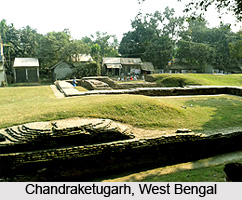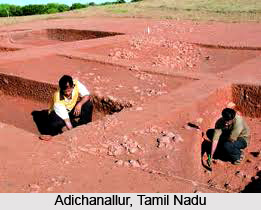 The history of archaeology in India dates back to the early sixteenth century and involves three groups of people namely Portuguese residents of Goa, other European sailors and occasional travellers. Principally, two categories of monuments are dealt with during this phase: the rock-cut caves of west India and the south Indian temples. Among the monu-ments in the interior, Elephanta was frequently described, and in the east the Black and White Pagodas, the Konark and Jagannatha temples of Orissa respectively, were known as early as the seventeenth century when they served as prominent navigational markers on the Orissan coast. By the middle of the eighteenth century, European familiarity with Indian monu-ments was fairly broad-based.
The history of archaeology in India dates back to the early sixteenth century and involves three groups of people namely Portuguese residents of Goa, other European sailors and occasional travellers. Principally, two categories of monuments are dealt with during this phase: the rock-cut caves of west India and the south Indian temples. Among the monu-ments in the interior, Elephanta was frequently described, and in the east the Black and White Pagodas, the Konark and Jagannatha temples of Orissa respectively, were known as early as the seventeenth century when they served as prominent navigational markers on the Orissan coast. By the middle of the eighteenth century, European familiarity with Indian monu-ments was fairly broad-based.
The formal beginning of Indian archaeology can be traced back to the mid-dle of the eighteenth century, when academic interest in the Indian antiq-uities began. The archaeology of India has got significance in the writings of some French scholars. The names of the major ancient Indian cities were known from the classical sources, and by the middle of the eighteenth century there was a specific geographical interest to identify them on the ground. Pataliputra, the ancient Mauryan capital described by the Greek ambassador to the Mauryan court, Megasthenes, was one of these cities.
In the second half of the eighteenth century there was considerable philosophical interest in the antiquity of India in Europe, especially among the philosophers of the French Enlightenment. The historical study of ancient India cannot realize its full potential on the basis of textual sources alone due to the fact that the sources which have been used, beginning with the Rig Veda, were not meant to be historical sources, and whatever historical information has been gleaned from them is not free from questions regarding their chronol-ogy, geographical applicability and even content. Except for the history of the kings of Kashmir, written by Kalhana in the twelfth century, there is no proper historical chronicle dating from the ancient period of Indian history. Great books which, like the Ramayana and the Mahabharata, have for ages served as popular encyclopaedias of national culture.
The problem of sources is not limited to the texts. It affects in good measure inscriptions, coins, sculpture, painting and architecture as well, although in these cases geography and chronology are not among the prob-lems. The number of early inscriptions is severely limited. They increase in number only in the twelfth-twelfth centuries, more in the south than in the rest of the subcontinent. But inscriptions are also textual compositions, and. like other textual compositions, devote a lot of space to conventional descriptions rather than to the enumeration of the event for which the in-scription was intended in the first place.
 Coins come mostly from `stashes`; accidental, non-contextual discoveries which very often end up with the coin-dealers. A framework of the study of coins has no doubt emerged, but on many occasions the study of ancient Indian coins has not been able to proceed beyond a study of their design. The same is true of the specimens of art and architecture. They are concerned much more with the religious life of the day in different regions and less with the issues of individual authorship and patronage, precisely the issues which would have made them exciting as historical documents.
Coins come mostly from `stashes`; accidental, non-contextual discoveries which very often end up with the coin-dealers. A framework of the study of coins has no doubt emerged, but on many occasions the study of ancient Indian coins has not been able to proceed beyond a study of their design. The same is true of the specimens of art and architecture. They are concerned much more with the religious life of the day in different regions and less with the issues of individual authorship and patronage, precisely the issues which would have made them exciting as historical documents.
Over the last two centuries or more, scholars have certainly mapped out the different areas of ancient Indian history. Archaeology can greatly expand the nature of the sources in the context of ancient India. Even in the areas with a much larger mass of detailed and rigorous textual documentation, archaeological research often leads to hitherto unperceived dimensions of the historical landscape. In the case of ancient India, where the basic quantum and the rigour of textual documen-tation are comparatively limited, archaeological research becomes more than ordinarily significant.
Archaeology can also greatly change the nature of historical questions, and it is here that the second reason of the significance of archaeology in ancient Indian historical research is rooted. Although modern archaeology is not afraid of handling a multitude of issues ranging from environment and subsistence to symbolism and cognition, it is primarily in the reconstruction of the story of man-land relationship through the ages that the subject excels. Through the excavations, ample information of Paleolithic and Mesolithic period is obtained that enriched the study of Archaeology of India as a whole.
The past is a hotly contested arena of modern times, and the fact that it has become so is in a large measure due to a sense of monolithic, racist past that India have inherited as a colonial legacy in a large part of the world. In the case of India, it is realized that since the beginning of research on the history of ancient India, the story of its conquest by a care-fully constructed `superior` racial and linguistic group called the Aryans has been an overwhelmingly dominant theme and that this conquest and the subsequent assimilation of the various indigenous strands of culture by the conquering Aryans have been said to constitute the very basis of an-cient Indian society and history.
 As far as the Third World countries go, the most pressing need these days is certainly to go beyond the bagful of colonial theories which they have all inherited and try to build up an image of themselves in which every member of their nation state can participate, irrespective of their regional, caste, tribal, religious, sectarian and a whole host of other affiliations. The primary sector of the past in which such a broad-based parti-cipation is possible is the history of their land, that particular patch of the earth`s surface which has befallen to their lot as a product of the historical circumstances and through which they have interacted in various ways through time. This approach makes archaeology predominantly a part of the environmental sciences.
As far as the Third World countries go, the most pressing need these days is certainly to go beyond the bagful of colonial theories which they have all inherited and try to build up an image of themselves in which every member of their nation state can participate, irrespective of their regional, caste, tribal, religious, sectarian and a whole host of other affiliations. The primary sector of the past in which such a broad-based parti-cipation is possible is the history of their land, that particular patch of the earth`s surface which has befallen to their lot as a product of the historical circumstances and through which they have interacted in various ways through time. This approach makes archaeology predominantly a part of the environmental sciences.
Thus, to learn a non-sectarian and multilineal image of ancient India, archaeology, especially aided by the scientific techniques which are now available to the cause of archaeological research, provides the most significant area of historical enquiry.






































